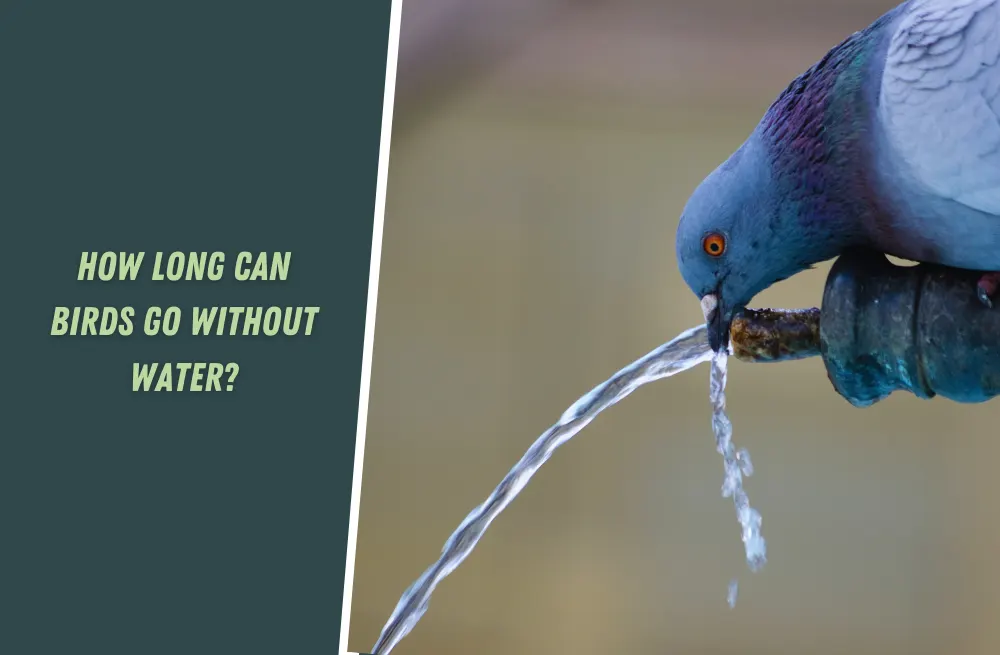Yes, male and female kangaroos exhibit noticeable differences in their physical characteristics, which can help distinguish between the two genders. These differences include size, body structure, head shape, and reproductive organs.
In terms of size, male kangaroos, known as boomers, tend to be larger and more muscular than female kangaroos, called does. Boomers can reach impressive heights of up to 6 feet (1.8 meters) and weigh around 200 pounds (90 kilograms), while does usually measure around 4 to 5 feet (1.2 to 1.5 meters) in height and weigh approximately 100 pounds (45 kilograms).
Male kangaroos also typically have broader and more robust heads compared to females. Additionally, boomers may display a prominent, muscular neck region, which is related to their territorial behavior and competing for mating opportunities.
Furthermore, male kangaroos often have well-developed chests and forelimbs, contributing to their strength and ability to engage in confrontations with other males. Female kangaroos, on the other hand, have a more streamlined chest and forelimb structure optimized for efficient hopping and nurturing their young.
In this article, we will explore the distinct characteristics that set apart male and female kangaroos, shedding light on their physical attributes and providing insights into their remarkable adaptations.
Size and Body Structure
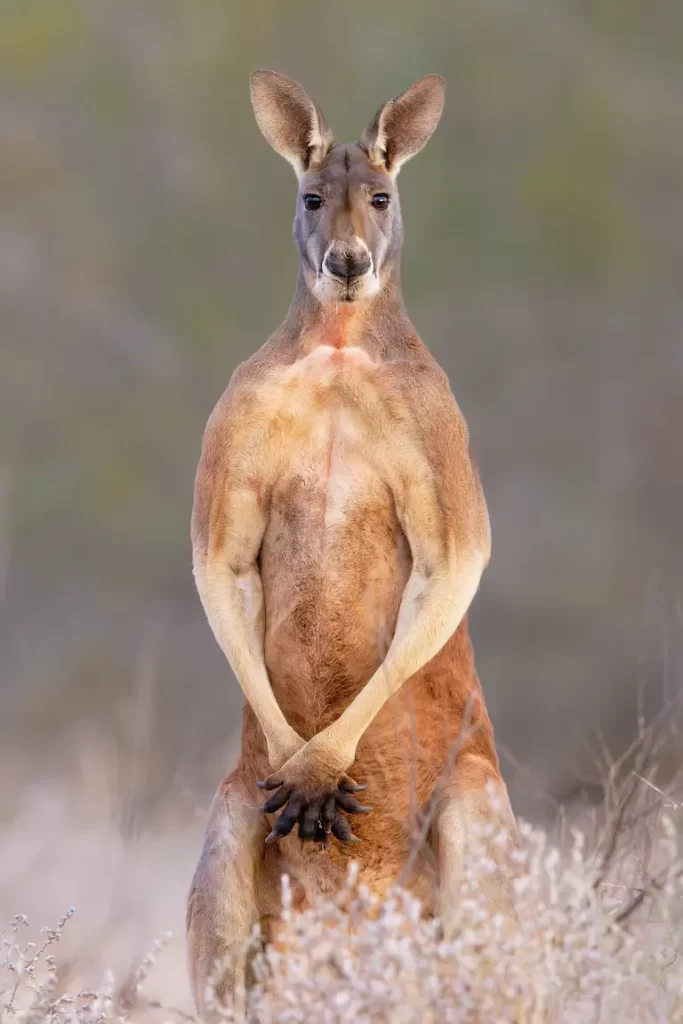
The size and body structure differences between male and female kangaroos are primarily driven by sexual dimorphism and the roles they play within their social groups. Male kangaroos, or boomers, undergo significant growth and development to attain their larger size and muscular physique.
This size advantage is advantageous during mating competitions and establishing dominance within the group.
The larger size of male kangaroos not only gives them a physical advantage in fights but also helps them intimidate rivals and attract mates. The competition among males for access to females is fierce, and size plays a crucial role in determining their success.
The larger and more dominant males have a better chance of mating with receptive females, passing on their genes to the next generation.
On the other hand, female kangaroos, or does, have a more compact and streamlined body structure. While they may not possess the same size and muscle mass as males, their bodies are well-adapted for efficient movement and reproductive responsibilities.
The smaller size and lighter weight of female kangaroos allow them to maneuver through their natural habitats with agility and grace. It also facilitates their ability to carry and nurture their joeys in their pouches.
Head Shape and Facial Features
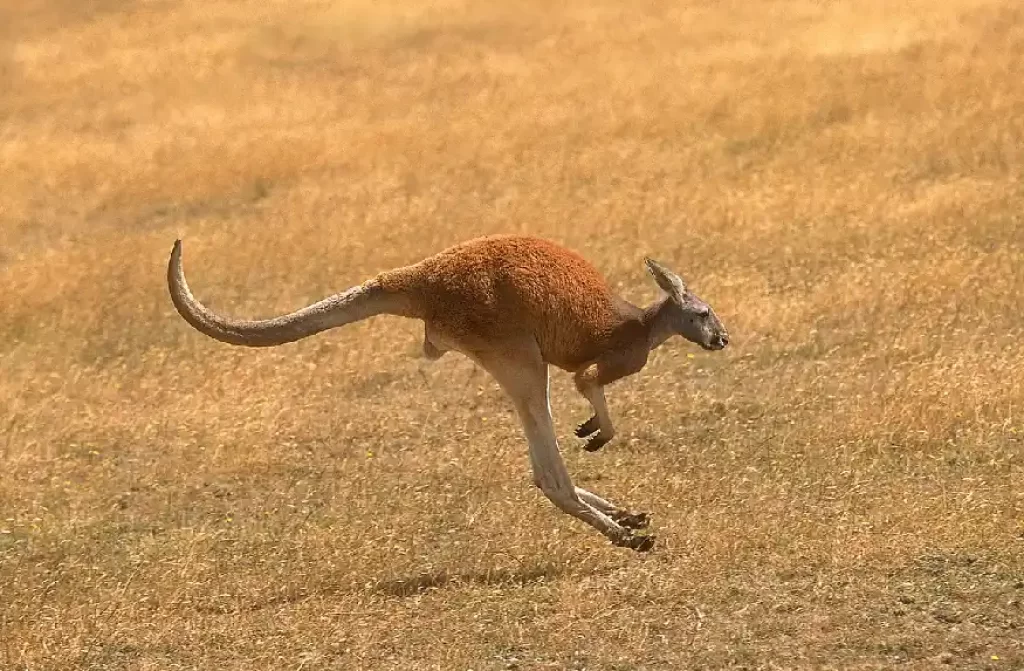
In addition to differences in size and body structure, male and female kangaroos exhibit variations in head shape and facial features. These distinctions can provide further insights into the sexual dimorphism of these fascinating creatures.
Male kangaroos, or boomers, often display broader and more robust heads compared to their female counterparts. This difference is primarily due to the development of strong neck muscles, which are essential for their territorial behavior and competing for mating opportunities.
The larger head size in males is related to their need for physical dominance and establishing their authority within the kangaroo social hierarchy.
While head shape can vary among individuals, certain facial features, such as the shape of the snout and the size of the ears, can exhibit subtle differences between male and female kangaroos.
However, it is important to note that these distinctions are not strictly gender-specific and can also be influenced by factors such as genetics and age. Individual variations within each gender group can lead to a range of head and facial characteristics.
Another noteworthy feature is the presence of prominent facial markings in male kangaroos. These markings, known as “cheek paddles” or “scent glands,” are patches of bare skin located on the cheeks. They are more commonly observed in mature males and play a role in chemical communication and marking territory.
Chest and Forelimb Development
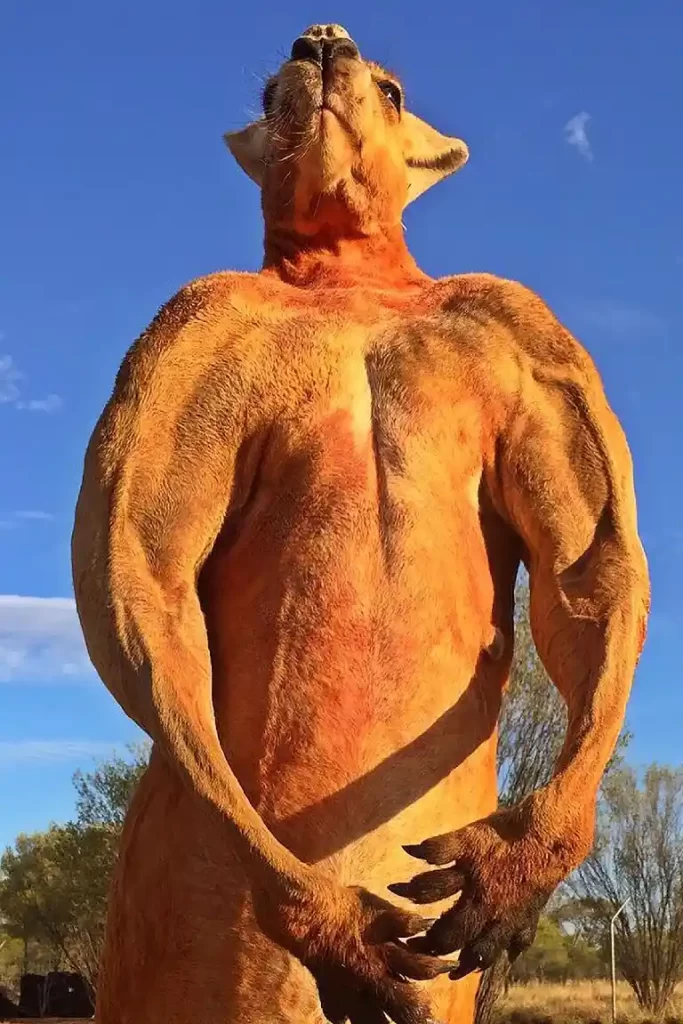
The dissimilarities between male and female kangaroos extend to their chest and forelimb development, reflecting their distinct roles and adaptations within their social dynamics.
Male kangaroos, especially the dominant boomers, typically exhibit well-developed chests and forelimbs. These muscular structures provide them with the strength and power necessary for engaging in confrontations with rival males during territorial disputes or competing for mates. The robust chest and forelimbs contribute to their ability to deliver forceful punches and grapples, making them formidable opponents.
On the other hand, female kangaroos have a more streamlined chest and forelimb structure, optimized for their unique locomotion and reproductive responsibilities. Their bodies are designed for efficient hopping, which is their primary mode of movement.
The streamlined chest allows for enhanced mobility and agility, enabling them to traverse vast distances while conserving energy. The forelimbs of female kangaroos are adapted for nurturing their young, as they spend a significant amount of time carrying and caring for their joeys.
It is important to note that while male kangaroos generally exhibit more developed chests and forelimbs, there can be variations within the male population due to factors such as age, dominance status, and genetics.
Similarly, female kangaroos may display slight variations in their chest and forelimb structure, influenced by factors like age and reproductive history.
The contrasting chest and forelimb development between male and female kangaroos aligns with their distinct roles in reproduction, competition, and adaptation to their environments.
These anatomical differences reflect the unique evolutionary strategies and physical attributes that contribute to the survival and success of each gender within the kangaroo population.
Coloration and Coat Texture
While male and female kangaroos share similar coloration and coat texture, there are some variations and individual differences that can make it challenging to distinguish between the genders based solely on these characteristics.
Kangaroos typically have fur coats that range in color from shades of brown to gray, allowing them to blend seamlessly with their surrounding environment and providing effective camouflage. This natural coloration helps them remain inconspicuous while foraging for food or seeking shelter.
However, it is important to note that variations in coat color can occur within kangaroo populations, making it unreliable to solely rely on coloration to differentiate between males and females.
Additionally, the texture of the fur coat in kangaroos is generally coarse and thick, serving as protection against the elements and potential threats.
The dense fur helps insulate their bodies, keeping them warm during colder periods, and provides some level of protection against scratches or minor injuries. Again, the texture of the fur coat does not differ significantly between male and female kangaroos, making it a less reliable indicator of gender.
To accurately determine the gender of a kangaroo, it is essential to consider a combination of physical characteristics, such as size, body structure, reproductive organs, and behavioral traits.
These factors, along with careful observation, provide a more comprehensive understanding of the differences between male and female kangaroos.
Why do only female kangaroos have pouches?
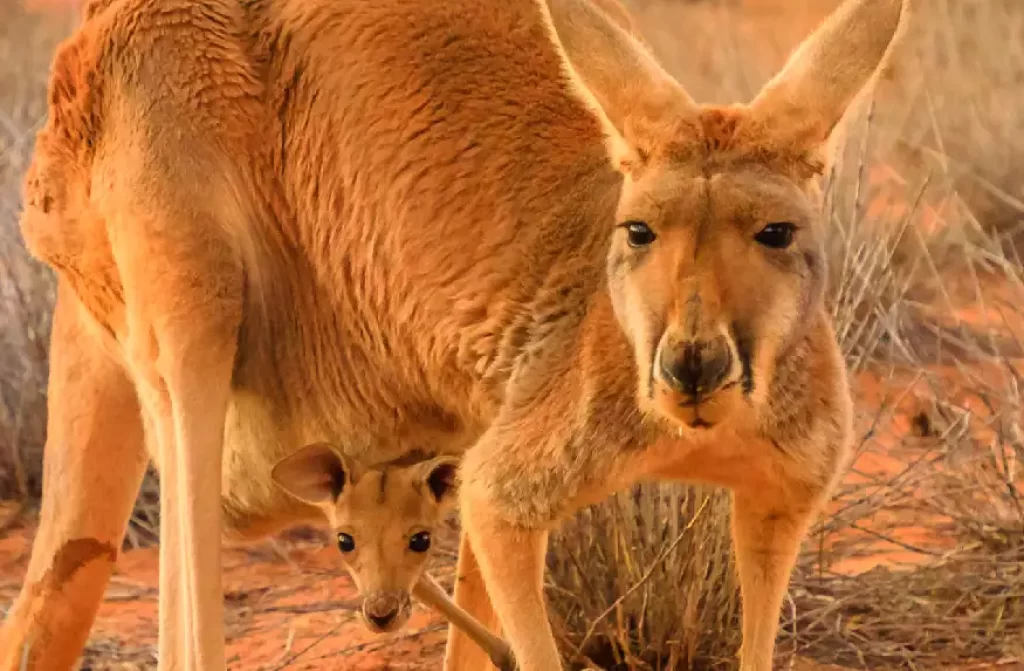
Female kangaroos have pouches because they possess a unique reproductive adaptation known as marsupial reproduction. The pouch, also called the marsupium, is a specialized external pouch located on the lower abdomen of female kangaroos.
During the reproductive process, female kangaroos give birth to relatively underdeveloped young, called joeys, after a short gestation period of about 30 to 40 days. At birth, the joey is just a tiny, hairless creature, approximately 1 to 2 centimeters in length. It is not capable of independent survival and is in need of protection and nourishment.
The female kangaroo’s pouch serves as a safe and nurturing environment for the joey’s continued development. Immediately after birth, the joey crawls into the mother’s pouch, where it attaches itself to one of her teats. Inside the pouch, the joey receives milk and continues to grow and develop for several months, gradually becoming more independent.
The pouch provides essential warmth, protection, and easy access to the mother’s milk, ensuring the survival and proper development of the joey. As the joey matures and becomes more self-sufficient, it will gradually spend less time in the pouch until it eventually ventures out on its own.
Related: Do Kangaroos Sacrifice Their Babies?
Do kangaroos get pregnant in their pouch?
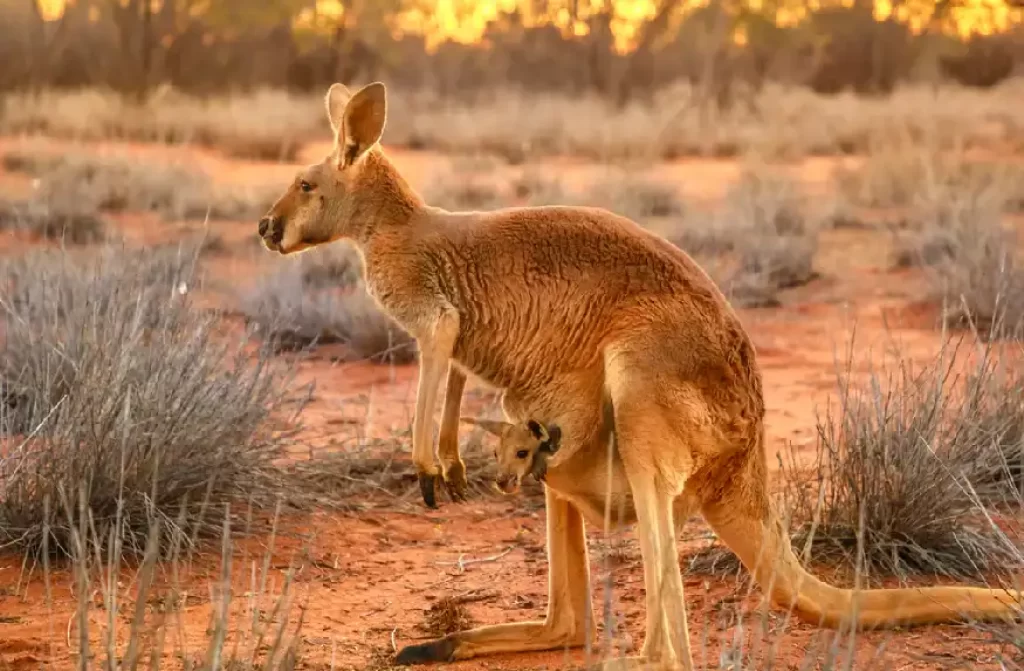
No, kangaroos do not get pregnant in their pouch. The pouch is not involved in the actual process of pregnancy. Instead, female kangaroos conceive and carry their young in a manner unique to marsupials, called embryonic diapause.
After mating, the female kangaroo’s fertilized egg undergoes a brief period of development before it enters a state of suspended animation. During this time, the embryo does not implant in the uterus but remains dormant. This delay in embryonic development is known as embryonic diapause.
Once the conditions are favorable, the embryo resumes its development and migrates to the mother’s uterus, where it attaches and continues to grow. The gestation period in kangaroos is relatively short, typically lasting around 30 to 40 days.
After the short gestation period, the female kangaroo gives birth to a tiny, underdeveloped joey. The newborn joey, only about the size of a jellybean, crawls into the mother’s pouch, where it attaches itself to one of her teats. Inside the pouch, the joey continues to grow and develop, receiving nourishment and protection until it is ready to venture out and explore the world on its own.
So, while the pouch plays a crucial role in the post-birth development of the joey, kangaroos do not get pregnant in their pouch. The pouch serves as a nurturing environment for the growth and maturation of the young after birth.
You might also like
- What do Kangaroos Look like When They are Born?
- Human vs Kangaroo: Who Wins the Ultimate Fight?
- How Many Kangaroos are there in Australia?
- What do Kangaroos Eat in the Desert?
- Can Kangaroos Move Their Legs Independently?
- Kangaroos Can’t Walk Backwards: Myth or Fact?
Conclusion
While male and female kangaroos share many physical similarities, distinct differences exist between the two genders. From variations in size and body structure to head shape, chest development, and fur texture, these features contribute to the unique characteristics of male and female kangaroos. By understanding these distinctions, we gain a deeper appreciation for the remarkable adaptations of these marsupials and their intricate roles within kangaroo social dynamics.






